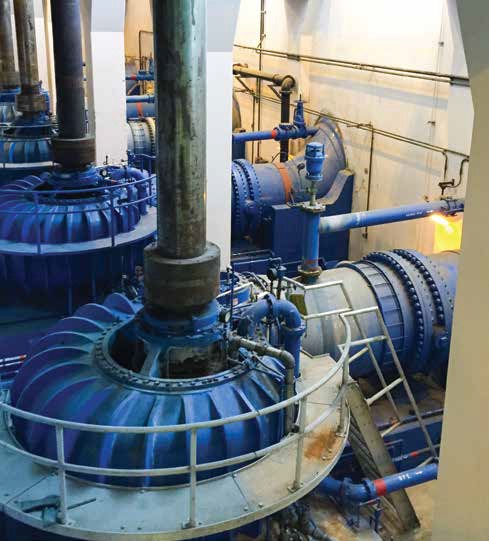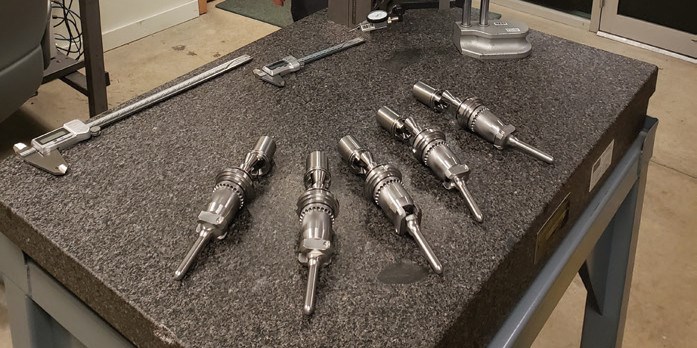Ed Edwards had a third-party inspector in his office reviewing the test requirements he was contracted to witness. The product being tested was an automatic recirculating valve used to provide minimum safe flow and perform the reverse flow check valve function.
“The tests would consist of a hydrostatic test per ASME B16.34, a seat test per API 598 and a performance test which would consist of measuring the Cv of the bypass with -0- main flow and several modulating points until the bypass port closed and all flow would go forward,” Edwards explained. “As an experienced inspector of mainly rotating equipment he was fine with the hydro and seat test, but as soon as Cv was mentioned he developed a confused look and had me repeat Cv at least two more times. I pulled a reference book for control valves and turned to the page with the Cv definition. After a quick review, he understood and we proceeded with the tests.”
As liquid flows through an orifice, the square of the fluid velocity is directly proportional to the pressure differential across the orifice and inversely proportional to the specific gravity of the liquid. The higher the pressure differential the higher the velocity, the greater the specific gravity the lower the velocity. Logically the flow volume of a liquid can be calculated by multiplying the fluid velocity times the flow area.
Using the Cv value for a valve or orifice can assist in determining the effect a change in pressure differential, flow rate, or specific gravity can have in a system with a simple calculation.
A Cv is numerically equal to the number of U.S. Gallons of water that will flow through the orifice or valve in one minute with a one PSI pressure differential.
Background and Experience
Edwards began his career with a pump and valve company in 1972 doing drafting work.
“In those days, we had equipment consisting of a T square, triangles, compass, soft lead pencils, and a slide rule was used for all design and price calculations,” Edwards remembered. “There was no email, no faxes, and no overnight courier services. The only fast nonverbal communication possible was to send a telex. Everything else went by normal postal mail. I was blessed to have several good role models that encouraged me to continue my education if I wanted to get off the drafting board.”
Edwards’ department supplied products to chemical industries and were often used on highly corrosive fluids, requiring materials of construction of exotic and high alloy materials including pure nickel, Hastelloy, titanium, and zirconium, in addition to many grades of stainless steels.
“I found use of these materials very interesting and started taking every metallurgy course available at Western Michigan University,” said Edwards, who completed his education in 1977 with a Bachelor of Science degree with majors in metallurgy and Industrial business. “The company I was with at the time sponsored me to take the NACE (National Association of Corrosion Engineers) course and obtain accreditation.”
Since graduating, he has worked as an application engineer, territory manager, sales manager, product manager, and vice president.
Now, Edwards works primarily on the technical and commercial review of bid requirements. He travels to plant sites to oversee maintenance and repair of HBE products and to review special or unusual product needs. He presents pump protection demonstrations at A&E firms, providing continuing professional development time for engineers to obtain or maintain a PE license. He also reviews and approves order quality documentation. He works for engineering and construction firms, universities, airports, and food processing facilities in a variety of industries, including oil and gas, pulp and paper, steel, power generation, and chemical.

Solving Problems with Valves and Pumps
Incorrect materials of construction can result in premature failure and safety hazards to personnel and the environment, according to Edwards.
“Using incorrect valve technology for the application is a big problem in industry,” he said. “I have witnessed large high-pressure gate valves becoming stuck by trying to close them under pressure. Other options, such as a parallel slide gate or metal seated ball or butterfly valves, would be better suited and the ¼-turn products are easily automated. Another big problem is when pumps operate outside of the manufacture’s intended range due to pumps being oversized or running multiple pumps when one will adequately handle the process needs.”
Edwards offers simple tips for end users when trouble-shooting problems.
“Read the manufacture’s IOM, and if you do not understand it, read it again,” Edwards suggested. “If you still do not understand it, contact the manufacturer. Establish a MTBR (mean time between repair) rather than MTBF (mean time between failure). The cost to repair is always going to be less expensive than waiting until failure occurs.”
When servicing equipment, cover any piping openings to avoid any debris from entering the system, he recommended.
“Some interesting items I have found in pumps and control valves include but are not limited to hex nuts, a 6-inch chisel, a 3-inch buffing wheel, plastic grocery bags, shop rags, and gloves,” he said. “Regardless of the automation and control room technology, a critical service pump such as a boiler feed should have quality, calibrated, and clean pressure gauges on the suction, discharge, and minimum flow lines. Baseline pressure readings should be recorded when the pump is new or recently serviced. Pumps are extremely reliable and what is often referred to as ‘pumping problem’ is often the result of a control valve failure, clogged strainer, or leakage in the piping. Changes in any of the three gauge readings should be investigated to determine and address the cause.”
With regard to safety, Edwards recommended following or exceeding PPE (Personal Protection Equipment) requirements of the site and always buy the best.
“Replace safety glasses if they get scratched and make sure ear protection is functional when working around high energy pumps,” Edwards said. “Disposable ear buds are okay in some situations, but muffs are much better when working near operating equipment. LOTO (lock out tagout), no doubt, prevents many accidents from happening. Most plants have a procedure in place and should have one if they do not. Once I was assisting in changing out trim on a control valve protecting a high pressure (3,800 PSIG) pump, and a worker that had been on site way longer than 12 hours started the pump before we had everything tight on the valve. As soon as the motor started, I was water blasted against a structural beam. My only injury was a cut lip, and I was glad to have been completely suited up in PPE and the water was ambient temperature! A LOTO would have prevented this accident that could have been much worse from happening. Safety rules are only good if they are followed!”
Challenging Projects
Edwards travels 30% of the time. His favorite projects are those that require him to determine and define problems and then formulate out-of-the-box solutions for them.
“I have been involved with several equipment failures due to unexpected corrosion in water services,” he said. “If a service is a known substance, such a 98% sulfuric acid, 40% caustic, or a finished petroleum product such as jet fuel or unleaded gasoline, it is easy to determine the material of construction for a pump, valve, or other piece of equipment.”
Throughout his career, a few interesting material failures have occurred on raw water intake systems, Edwards said.
“Even if water samples are taken and a close analysis is performed, variables from seasonal or other mother-nature influences can present a challenging surprise,” he explained. “An interesting example occurred at a large facility in Nigeria in which carbon steel bodied valves with internal parts of 304 and 17-4PH materials were fine for approximately seven years, then failed from corrosion. Replacements lasted less than one year. Upgrades were made in materials by changing from carbon steel to 316 stainless-steel bodies and internal parts of 304 were also upgraded to 316. 17-4PH parts were changed to Nitronic 60. Three years have passed without any corrosion failures. The site never reported if the root cause of the failure was determined but based on some other installations, I suspect the raw water being obtained directly from a river had some type of new actor that was biological in nature.”
Another site in rural Pennsylvania has a similar problem and it was determined a parasite in the raw water would eat any material of construction less than 316. This was determined before a new plant was built and correct materials of construction were used from the start, Edwards said.

Current Industry Trends
Consolidation of companies at both the user and supplier level is trending in the industry, Edwards said.
“Knowing the history is an important aspect often overlooked in many businesses, and the ‘brain drain’ of many companies has been tremendous,” he said. “Supplier reductions by appointing middleman contracts adds to the confusion when the user does not understand what he needs and expects the middleman to work it out with a supplier employee that is inexperienced.”
Edwards predicted continued automation and instrumentation “smart” technology advancements.
“We will continue to improve the efficiency and safety in industry, however, as I mentioned earlier, the basics still need to be understood or all the information viewed and or recorded will not take the place of knowledge and experience. For example, a control room operator of a crude oil pipeline received a drop in pressure signal. The operator assumed the operating pump was sick and brought the standby pump online and shut down the pump that was losing pressure. The pipeline pressure continued to drop and to compensate. The speed of the pump was increased to increase the pipeline pressure, however, it continued to drop. The pressure loss was due to a pipe leak so the leak plus the flow through the pipeline resulted in the pump running out on its curve and operating at a lower pressure. A massive spill resulted due the time it took to determine the reason for the pressure loss.”
Advice for End Users
Learn by starting with the basics until they are understood, Edwards advised young end users.
“These days, everyone wants to obtain information online, but anyone involved with pumps and valves need a few good reference books,” he suggested. “Some of my favorites include Hydraulic Institute Standards, Pump Handbook by McGraw Hill, Lyons’ Valve Designer’s Handbook, NACE Corrosion Data Survey, Cameron Hydraulic Book, and ASME B16.34. Pump engineers, in general, need to know more about valves. Valves normally control the pumps output and many valve types protect pumps from damage, for example, check valves and minimum flow valves. Also, valves are key to safely servicing pumps.
Valve engineers also need to know more about pumps for the same reasons.
“Both need to know about Cv calculations and values and how they can be used in determining the effect changes in pressure, flow, and how specific gravity can effect each other.”
Edwards also recommends that end users do not specify requirements he or she does not understand.
“Many specifications are developed by cut-and-paste of work done for a different item,” he said. “For example, do not specify a magnetic particle test be done on a stainless steel part. It cannot be done. Suppliers have a wealth of experience and knowledge. Use it! Attend seminars, lunch & learns, and trade shows, if possible, and never be afraid to ask questions. Seek out a mentor. I was blessed to have several very good ones early in my career, and I’m sure glad I did.”


